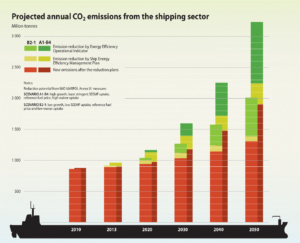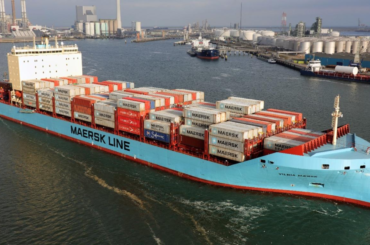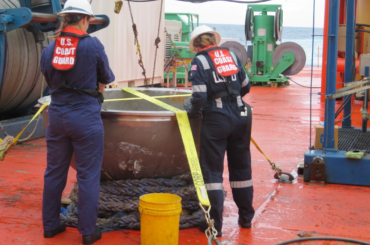The world trade is really running on the hands of the shipping industry. Hence, 90% of the world trade volume is carried by shipping and related activities. As a matter of fact shipping industry gradually changed from sail power to the coal power of steamships, to the predominance of heavy fuel oil and marine diesel oil. This energy change or the power creation is heavily affected on every aspect of human beings lifestyle. Additionally, an increment of deadweight tonnage can be seen in (81 million) can be seen in 2019-2020.
The world’s merchant fleet consists of around 100,000 ships. And these are estimated to consume 250 million tonnes of bunker fuel annually. To express this, just one bulk carrier can use about 40 metric tonnes per day. Consequently, this leads annual fuel consumption of 10,400 tonnes resulting in the emission of 33,000 tonnes of carbon dioxide (CO2) and 959 tonnes of sulphur oxide (SOx). The unfavorable gases cannot be reduced because carbon dioxide emissions from shipping are a result of recent human activity. ( 4%-5% of the global)
Shipping and Emission of Gases.
According to the International Maritime Organization (IMO), in 2012, the emission of carbon dioxide from the shipping industry (CO2) was around 2.2% of the total global emissions. The point is the percentage value of carbon dioxide and other unfavorable emissions are increasing continuously. As a matter of fact, all the transport-related unfavorable gas emissions are around 9% of total emissions. In fact, the International maritime organization says that maritime emissions could grow between 50% and 250% by 2050.

These gases root for a significant amount of damage to the environment and cause bad human health. One of the major adverse effects of these emissions is climatic change trapping heat in the atmosphere. These human enhanced greenhouse gases utilize emissions precipitates in the atmosphere and stimulus to changes in the ecosystems. Because adding heat energy to a system can change any system from its initial stage. This crucial amount of emissions leads to more evaporation. And results in droughts and wildfires, more precipitations in irrelevant areas, warmer oceans that provoke stronger storms.
One of the ideal example can be stated as per this. Hurricane Matthew in 2016 and hurricane Dorian in 2019. Reconsideration of voyage plans in cruise lines and merchant vessels are accounted for both the hurricanes. Furthermore, on 24th March 2021, MV Ever Given container ship stuck in the Suez Canal due to a sand storm and which causes long tailbacks on this busiest route resulting in marine traffic and creates barriers in providing necessary food items and vaccines, etc.
The unpredictability of weather conditions take part in scheduled route changes, vessel sinking, assist another ship at sea who are in danger, vessel rerouting and also the safety of crew and guests are at risk. Moreover, shortages in container transshipment (transshipment fallout) and period extension inflow of containers as volume is pushed to other hubs likely creating congestion. Damage to operating facilities like in liquid bulk import terminals suffers a lot in their supply chains and continuous workflows in refined product industries.
Role of Non-renewable energy resources in Shipping Industry.
In human health perspective, these gas emissions cause countless adverse outcomes in the areas of physical, social, and psychological. For an instance, changes in precipitation are creating changes in the availability and quantity of water. Along with the emissions, these toxic gases are so much vulnerable in children as well as elder people causing asthma and other cardiovascular diseases. Similarly, inflammation in skins, bone demineralization, kidney calcification, oxidative stress, and endothelial dysfunction are major health risks. The day where our world suffers from those illnesses are not far away if we work together to reduce these emissions.
However, people have started finding solutions for this issue and those solutions will comfort and cool down the atmosphere to bring back our paradise. Using renewable energies for shipping is one of the major solutions among them. The concept of de-carbonization is the most critical point in sustainable energy usage. Normally the renewable energy sources are naturally replenishing but the flow is limited and at the same time that is sustainable. Renewable energy is also referred to as “alternative energy” since it is an alternative energy source for fuel and coal etc.

Thus solar energy, wind energy, hydro energy, tidal energy, geothermal energy and biomass energy are the most common currently using energy sources. Replacement of Fossil fuels with ready-to-use bio Fuels (Bio-LNG) leads to reduction of unfavorable gas emission. . Using these fuels can reduce the effect of emissions even eliminate them. For short-distance shipping like ferries and small vessels, converted into electric ships that run through the battery is a possible option. Not all in the energy sector, sustainability in shipbuilding and production and sustainability inshore operations like loading and unloading cargoes, containers, and liquids should also be considered.
References
eNCA, 2021. eNCA. [Online]
Available at: https://www.enca.com/news/giant-ship-blocks-suez-canal-after-running-aground-sandstorm
[Accessed 25 03 2021].
Frangoul, A., 2018. CNBC. [Online]
Available at: https://www.cnbc.com/2018/05/04/the-ideas-that-could-transform-the-shipping-industry.html
[Accessed 20 03 2021].
FUELSAVE, n.d. FUELSAVE. [Online]
Available at: https://fuelsave-global.com/losungen/fs-marine/
[Accessed 22 03 2021].
Ltd., M. M., n.d. Green Port. [Online]
Available at: https://www.greenport.com/news101/energy-and-technology
[Accessed 22 02 2021].
Miller, G., 2019. American Shipper. [Online]
Available at: https://www.freightwaves.com/news/how-hurricane-dorian-could-impact-ocean-shipping
[Accessed 22 03 2021].
Nunez, C., 2019. National Geographic. [Online]
Available at: https://www.nationalgeographic.com/environment/article/greenhouse-gases#:~:text=They%20cause%20climate%20change%20by,change%20caused%20by%20greenhouse%20gases.
[Accessed 21 03 2021].
Øyvind Endresen, E. S. H. L. B. P. O. B. I. S. A. I., 2007. AGU. [Online]
Available at: https://agupubs.onlinelibrary.wiley.com/doi/full/10.1029/2006JD007630
[Accessed 21 03 2021].
ScienceDirect, n.d. ScienceDirect. [Online]
Available at: https://www.sciencedirect.com/topics/engineering/sustainable-energy
[Accessed 21 03 2021].
Wilhelmsen, W., n.d. wallenius wilhelmsen. [Online]
Available at: https://www.walleniuswilhelmsen.com/news-and-insights/highlighted-topics/orcelle
[Accessed 20 03 2021].







